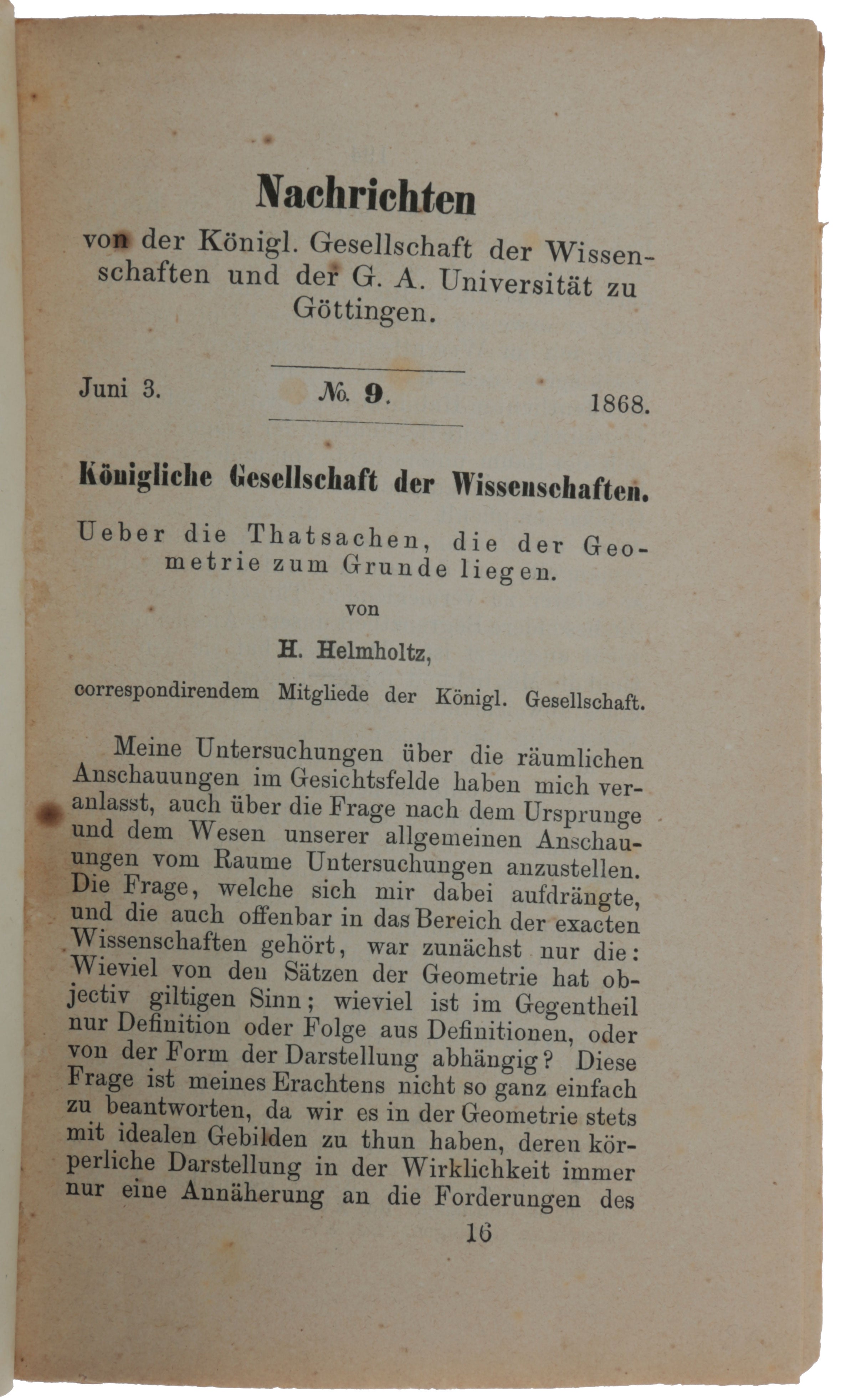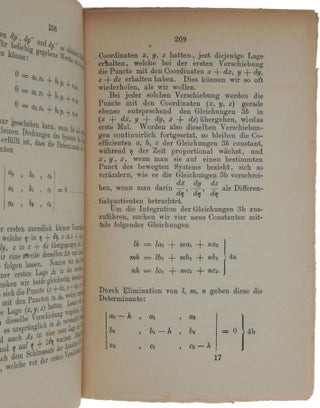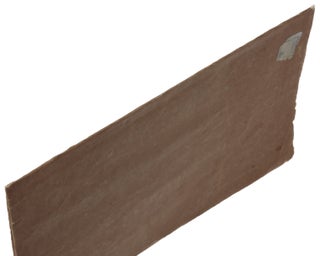Ueber die Thatsachen, die der Geometrie zum Grunde liegen, pp. 195-221 in: Nachrichten von der Königlichen Gesellschaft der Wissenschaften und der G. A. Universität zu Göttingen, Bd. 15, No. 9, June 3, 1868.
Berlin: Königlichen Akademie der Wissenschaften, 1868. First edition, very rare, of Helmholtz’s famous and important contribution to non-Euclidean geometry, ‘On the facts which lay at the foundations of geometry’. “Motivated by his study of visual perception, throughout the mid-1860s Helmholtz investigated the most general analytic expressions of spatial relations. He formulated for himself the abstract mathematical concept of the extended n-ply manifold and became convinced that tacit assumptions of congruence and translation underlie the Euclidean axioms. In 1868, before publishing these results, he received a copy of G. F. B. Riemann’s treatise of 1854 [not published until 1868], Ueber die Hypothesen, welche der Geometrie zu Grunde liegen [‘On the hypotheses which lay at the foundations of geometry’]. Riemann had assumed that in any manifold the distance formula ds must be the square root of a homogeneous function of second degree in dx, dy, dz, and so on. Helmholtz, starting from the assumption of congruence, proved that Riemann’s formula must follow necessarily from that assumption” (DSB). “Though he shared with Riemann the fundamental idea that geometry ultimately rested on physics, rather than on transcendental ideas, Helmholtz replaced Riemann’s ‘hypotheses’ with ‘facts’ … Helmholtz argued that fundamental physical facts necessitate the quadratic form of the line element. Specifically, he assumes: (1) Continuity and dimensions (each point in space is determined by n continuous, independent variables); (2) The existence of moving and rigid bodies; (3) Free mobility (meaning that ‘each point can pass over into any other along a continuous path’); and finally, (4) The invariance of the form of rigid bodies under rotation.’ From these premises, he deduced that ‘if we desire to find the degree of rigidity and mobility of natural bodies attributable to our space in a space of otherwise unknown properties, the square of the line element ds would have to be a homogenous second-degree function of infinitely small increments of the arbitrarily chosen coordinates. This proposition … [is] the most general form of the Pythagorean Theorem. The proof of this proposition vindicates the assumption of Riemann’s investigations into space … [It also] has deep implications for Einstein’s geometric account of gravitation because it dictates the fundamental form of the metric” (Pesic, pp. 277-8). “Einstein considered Helmholtz’s connection of geometric hypotheses to empirical facts as absolutely crucial for the general theory of relativity, whose field equations epitomize that connection” (Pesic, p. 285). No offprints of Helmholtz’s article are recorded – since it occupies a complete issue of the Nachrichten, the publisher may have thought it unnecessary to produce any. ABPC/RBH list only the Plotnick copy of the complete journal volume (Christie’s, New York, 2002). Helmholtz began his formal work on geometry in 1866, when he was finishing the third part of his Handbuch der physiologischen Optik. His aim was to give a mathematical answer to Kant’s question: if the apparent certainty of geometry rests upon the intuitive validity of geometrical constructions, what is the foundation for the soundness of these intuitions? Helmholtz answered that exact geometrical measurement relied ultimately on the concept of congruence, and that this concept necessarily involved an empirical element imported from outside of geometry, namely the motion of rigid bodies. “In 1868, he learned of Bernhard Riemann’s habilitation lecture, ‘Ueber die Hypothesen, welche der Geometrie zu Grunde liegen.’ In April 1868, he wrote to Ernst Schering in Göttingen to request a copy of Riemann’s lecture, and explained: ‘I myself have been occupied with the same subject for the last two years in connection with my investigations in physiological optics, but the work is not yet completed and published because I still hope to be able to generalise a few points. In particular I cannot make everything as general for three dimensions as I can for two. Now I see that Riemann came to exactly the same results as I did.’ “While Riemann’s and Helmholtz’s approaches and conclusions actually differed in important ways, they did agree on several fundamental points. First, they both presented a generalised notion of space as a manifold of several dimensions, defined independently of the metrical relations associated with geometrical space; they pointed out that the metrical relations were not defined on such a manifold naturally, but only by way of special assumptions about the comparison of special magnitudes. Second, they both asserted that only spaces of uniform curvature allowed for the free motion of rigid bodies without change of form or dimension. Third, they found that the measurement of distances in any such space is given by a generalised form of the Pythagorean theorem (that is, by a quadratic equation in the coordinate differentials of the space). For the most part then, Helmholtz independently arrived at a version, restricted to three dimensions, of Riemann’s general treatment of metric spaces of constant curvature. “Riemann’s more general treatment notwithstanding, Helmholtz decided to complete and publish his own work because it had a strikingly unique starting point. He sought answer the question: ‘what must be the nature of a magnitude of several dimensions if rigid bodies (i.e. bodies of unvarying relative measurements) are to be able to move everywhere in it continuously, monodromously, and as freely as bodies move in actual space’ … “He began by proposing new geometrical postulates that contained some explicit mathematical definitions, first, of space as a magnitude of several dimensions, and, second, of the set of physical facts (in idealised form) that permit the geometrical treatment of space. He presented four ‘Hypotheses which lie at the foundation of the investigation.’ First, space of n dimensions is an n-fold extended manifold, that is, its element, the point, is specified by n independently, continuously, and differentiably variable quantities. Second, there exist movable but internally rigid point systems (bodies); this assumption, he noted, ‘is necessary so that the comparison of special magnitudes by congruence can be carried out.’ To avoid presupposing any method of measurement, he stated the assumption analytically: ‘Between the 2n coordinates of any point-pair belonging to a rigid body, there is an equation independent of the body’s motion that is the same for all congruent point-pairs.’ Third, rigid bodies are capable of completely free motion so that the points of any one can be carried into the place of any other without changing their internal relations. This assumption made congruence independent of place. Helmholtz here remarked that in the visual field, retinal images enjoy a restricted kind of mobility on the retina, thus underscoring the continuity between his mathematical hypotheses and his hypotheses about perceptual learning. Fourth and finally, the relation of congruence is not affected when a body is transposed into itself: that is, a rigid point-system, rotated about any axis, eventually returns exactly to the place from which it started … Thus, Helmholtz offered only one rather weak assumption about space, specifying only its topological and differentiable structure, and he proceeded to derive all further structure, especially metrical structure, from the three postulates about motion. “Helmholtz first applied these postulates to the case of a vanishingly small body (an infinitesimally separated point-pair) in a three-dimensional space. He gave a proof for what Riemann had taken as a hypothesis – namely, that the distance between the points must be expressed by some particular case of the generalised Pythagorean quadratic form, now known as a Riemannian metric. He also derived Riemann’s claim that if we assume the rigid mobility in space of bodies of finite size – to which the ordinary bodies are our experience are approximations – then the space must be one of constant curvature, of which Euclidean space is but a special case. If we add to the postulates given that space is three-dimensional and infinitely extended, then, Helmholtz concluded, we obtain ‘the sufficient foundations for the development of the theory of space.’ By this claim he meant that these postulates narrow down the generality of the first four to the case of the space of our experience, which therefore would have to be either Euclidean or of constant negative curvature |(since the requirement of infinite extension would exclude spherical spaces). It followed that only empirical measurements could determine which of the two alternatives was correct. All of these results showed, he added, that ‘the independence of congruence from place, from the orientation of congruent special figures, and from the path on which they are transposed into one another, is the fact on which the measurability of space is based. “Perhaps because he was convinced that (approximately or sufficiently) rigid bodies really existed, he did not try to match Riemann’s generality; except as a mere mathematical possibility, he did not seriously consider the possibility of spaces where his postulates would not hold … “There were thus two reasons for Helmholtz’s claim to have presented ‘the facts which lie at the foundations of geometry,’ whereas Riemann had more circumspectly written ‘on the hypotheses.’ First, Helmholtz’s acceptance of ordinary congruence as the necessary foundation of geometry, rather than merely as its historical origin and its present basis, admittedly showed a certain narrowness of view and complacency, at least in comparison with Riemann. This acceptance seemed to imply that the Riemannian character of the metric and the condition of constant curvature had been shown to be factual rather than hypothetical, and that other possibilities could be excluded. The second reason was more compelling: since we are in fact able to treat certain bodies as effectively rigid, it is simply a fact, and not an apodeictic certainty, that geometry is possible as a science” (DiSalle, pp. 509-513). Einstein’s debt to, and praise of, Riemann’s work on the foundations of geometry are well-known. “Einstein’s words in praise of Riemann are far better known than his … 1925 hommage: ‘[that] all propositionsof geometry gain the character of assertions about real bodies … was especially clearly advocated by Helmholtz, and we can add that without him the formulation of relativity theory would have been practically impossible.’ Einstein considered Helmholtz’s connection of geometric hypotheses to empirical facts as absolutely crucial for the general theory of relativity, whose field equations epitomize that connection” (Pesic, p. 285). Helmholtz’s insistence that free motion is possible in space also heavily influenced Felix Klein’s ‘Erlangen Programm’ (1872), in which spaces are studied via the groups of continuous transformations which they admit. “As Klein remarked in 1893, ‘our ideas of space come to us through the senses of vision and motion, the ‘optical properties’ of space forming one source, while the ‘mechanical properties’ form another; the former corresponds in a general way to the projective properties, the latter to those discussed by Helmholtz’” (Pesic, p. 283). Helmholtz published a brief non-technical abstract of the present paper under the title ‘Ueber die thatsächlichen Grundlagen der Geometrie’ (Verhandlungen des naturhistorisch-medicinischen Vereins zu Heidelberg 4, 197-202). In many references, the date of publication of this abstract is given as 1866, based on a note in Helmholtz’s Wissenschaftliche Abhandlungen. However, Klaus Volkert has shown conclusively that the date of publication was 1868. In fact, Helmholtz delivered the talk with this title to the Heidelberg ‘Verein’ on 22 May 1868, so it cannot have been published in the Verhandlungen much before, if at all before, the publication of the full paper, which appeared in the issue of the GöttingenNachrichten dated 3 June 1868. Sommerville, p. 41. DiSalle, ‘Helmholtz’s empiricist philosophy of mathematics,’ pp. 498-521 in: Hermann von Helmholtz and the Foundations of Nineteenth-Century Science (Cahan, ed.), 1993. Neuber, ‘Helmholtz’s theory of space and its significance for Schlick,’ British Journal for the History of Philosophy 20 (2012), pp. 163-180. Pesic, ‘Helmholtz, Riemann, and the Sirens: sound, color, and the ‘Problem of Space’,’ Physics in Perspective 15 (2003), pp. 256-294. Volkert, ‘On Helmholtz’s paper ‘Ueber die thatsächlichen Grundlagen der Geometrie’,’ Historia Mathematica 20 (1993), pp. 307-309.
Small 8vo (183 x 114mm), pp. [193], 194-222 (light browning, bookseller’s inventory number (?) pasted onto last page of text). Contemporary plain wrappers (worn at edges, upper outer corner of rear wrapper broken off, remnant of bookseller’s label on front wrapper).
Item #5428
Price: $5,000.00







